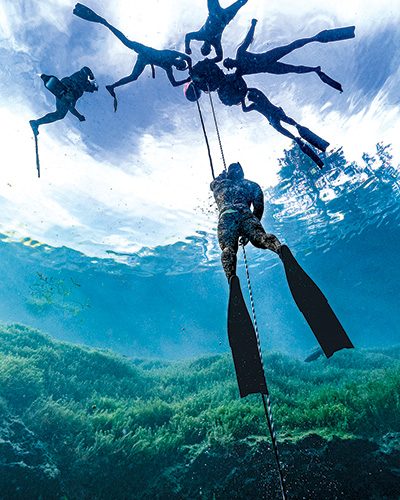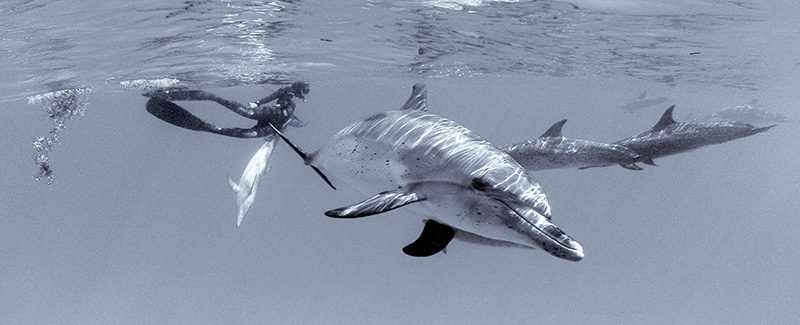EN LA DÉCADA DE 1990 UMBERTO PELIZZARI era un joven buzo de Busto Arsizio, Italia, que aparecía en los titulares por romper récords mundiales en el buceo en apnea con peso constante y peso variable. Como necesitaba una ventaja frente a su archirrival, Francisco “Pipin” Ferreras, solicitó asesoramiento sobre aletas a un amigo que era conocedor de equipo de buceo en apnea innovador: Valerio Grassi, fundador de Omersub.
La tecnología de competición automovilística había comenzado a usar materiales compuestos, así que los dos amigos diseñaron algunos prototipos de aletas de materiales compuestos para futuras pruebas. El objetivo de Pelizzari era, con el tiempo, superar los 80 metros (262.4 pies) con una sola respiración en un buceo en apnea con peso constante. Con sus aletas de buceo en apnea de materiales compuestos logró establecer numerosos récords y consiguió su objetivo, y estableció un nuevo récord mundial con un buceo en apnea de 80 metros (262.4 pies) con peso constante en octubre de 1999. La película de IMAX de 2001 de Bob Talbot Ocean Men: Extreme Dive : Extreme Dive (Hombres del océano: buceo extremo) presenta la histórica rivalidad entre Pelizzari y Ferreras.
Con casi 25 años de experiencia en la industria de los equipos de buceo, he sido testigo de todos los cambios y avances en lo que respecta a las aletas de buceo en apnea. En la década de 1990 los principales fabricantes produjeron aletas de plástico de palas largas con longitudes similares, pero con diferencias sutiles en la geometría de las palas y la forma de los terminales. Algunos diseños más avanzados incorporaron una curva en la planta de las palas de las aletas donde se unen a los escarpines. Algunas aletas tenían diseños modulares con escarpines conectados a la pala por medio de broches y tornillos; otras tenían diseños con una sola pieza moldeada.
Todavía estaba por verse qué diseño era finalmente mejor. En ese entonces, la teoría elemental era que las palas más rígidas impulsarían más a un buzo. Los buzos que descendían a grandes profundidades necesitaban un mayor empuje, y la flotabilidad negativa adicional superior a 2 o 3 atmósferas requería un impulso adicional de la pala para que el buzo pudiera regresar a la superficie.

Diferentes materiales —incluso fibra de vidrio, Kevlar, fibra de carbono y hasta materiales transparentes de la industria óptica— fueron integrados a las aletas. Los apneistas que querían una ventaja competitiva experimentaron con materiales que proporcionarían la propulsión y conservación de energía más eficaz para los apneistas privados de oxígeno que caían en picada y regresaban de las profundidades.

Para principios de la década de 2000 algunos fabricantes produjeron y comercializaron aletas de pala larga y talón abierto, no tanto para los apneistas, sino para los buzos con aire comprimido que usaban botines y querían un diseño con correas para poder colocárselas y sacárselas rápidamente. Estas aletas eran ideales para buzos que se desplazaban en corrientes intensas y que hacían largos buceos a la deriva y para perseguir estudiantes. Más adelante nuevos materiales cambiaron las reglas del juego para las aletas de buceo en apnea de palas largas. Los mercados pasaron de un 95 por ciento de polímero plástico y termoplásticos —nombres extravagantes parea los derivados de la poliamida y el plástico que se usan en el moldeado por inyección— a una amplia variedad de materiales compuestos.
La funcionalidad de las aletas de buceo en apnea se agilizó a partir de este momento. Lo que no había cambiado desde las aletas de plástico de la década de 1970 evolucionó con el uso de materiales compuestos para palas y escarpines de multicomponentes termoplásticos modulares que se unían a las palas de las aletas por separado.
El cambio a los nuevos materiales para aletas se basó en un deseo de mayor seguridad debido a un aumento de los accidentes de buceo en apnea. Contrario a la creencia anterior de que las palas más rígidas tenían más eficacia a profundidad, resultó ser una receta mortal para los desvanecimientos en aguas superficiales. Los buzos que se sumergían a profundidad necesitaban una rigidez extra para sobrellevar la flotabilidad negativa adicional, pero la mayor rigidez para un buzo en apnea laborioso que se esforzaba por dirigirse a la superficie tensionaba excesivamente los músculos de sus piernas.
Los fabricantes llegaron a la conclusión de que las necesidades de rigidez de las palas dependían del tipo de cuerpo y la estatura del buzo, tal vez sin interpolar a la población de buceo en apnea en general. El diseño evolucionó e incorporó materiales alternativos para ahorrar energía y peso.
En general, la fibra de carbono se considera el material más eficaz para las aletas de buceo en apnea —no solo por su excelente relación rigidez-peso, sino también por su capacidad de respuesta y reacción—. Las aletas de buceo en apnea de fibra de carbono correctamente moldeadas con el grado de rigidez adecuado impulsarán al buzo a profundidad de manera eficiente y minimizarán el gasto de energía.
Como punto de partida general para determinar la dureza o rigidez de las aletas, un buzo que pesa menos de 68 kilogramos (150 libras) normalmente seleccionaría una pala de aleta de rigidez reducida o 20-25. Un buzo que pesa entre 79 y 91 kilogramos (175 y 200 libras) normalmente utilizaría una rigidez media o 30 y un buzo más pesado debería optar por una pala de aleta de rigidez elevada o 40, pero existen excepciones a estas recomendaciones. Algunos instructores y profesionales, por ejemplo, prefieren las palas de aleta que son más rígidas de lo que su estatura indicaría para tener una respuesta y una propulsión más rápidas.
Las palas de aleta de carbono también vienen en diferentes formas y longitudes. Las aletas largas pero livianas generan menos fatiga en los cuádriceps de un buzo. La longitud extra de las palas impulsa al buzo con menos aleteos en comparación con las aletas de longitud regular. Al desplazar mayores volúmenes de agua, las aletas largas permiten reducir la cadencia a patadas más largas, suaves y de rotación completa con un menor desplazamiento.
Las aletas de fibra de carbono pesan aproximadamente 453 a 680 gramos (1 a 1,5 libras) cada una, y los escarpines generalmente se unen a la pala con un kit de tornillos de fijación. Con los escarpines de talón cerrado, los buzos por lo general usan calcetines de 2 mm a 3 mm, que son demasiado finos para los buzos de agua fría, quienes normalmente usan una aleta de talón abierto con correa con botas de neopreno para mantener sus pies calientes.
La variable más importante al elegir una aleta adecuada es el calce del escarpín. Una vez que encuentre un escarpín cómodo y ceñido, puede acotar las palas fácilmente basándose en unos pocos criterios, como su estatura, la profundidad a la que bucea más comúnmente y el tipo de buceo en apnea o deportivo que realiza —como pesca con arpón, fotografía, intentos de inmersión a profundidad o natación desde la superficie—.
Muchas aletas son modulares, lo que significa que las palas se separan para poder cambiarlas o para que sea más fácil viajar con ellas. Una bolsa para aletas de buceo en apnea adecuada es una excelente inversión para viajar en avión para que pueda empacar sus objetos personales en ella y guardarla en el compartimiento superior. La fibra de carbono es más fuerte que el plástico, y son bastante duraderas cuando se les da el uso previsto.
© Alert Diver - Q4 2023